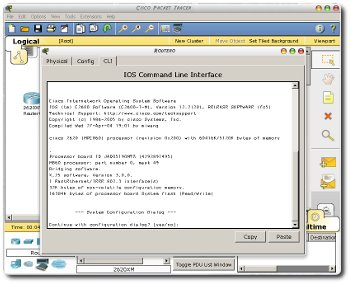Using Cisco Packet Tracer on Linux
(Or: Using Wine where plain-water should have been more than enough.)
Packet Tracer is a network simulator for Cisco devices. Caveat: It runs only on Windoze. Hence, there are three possible solutions for someone in need of using Cisco simulation on Linux:
- Wine: Wine’s setup varies from distribution to distribution. If you’re using Ubuntu, following commands should do the trick:
[user@host ~]$ sudo apt-get install wine [user@host ~]$ winecfg
Alternatively, for Fedora/RHEL/CentOS, use:
[user@host ~]$ sudo yum install wine [user@host ~]$ winecfg
Followed by:
[user@host ~]$ wine /path/to/PacketTracerSetup.exe
Once installed, you end up with:

(Click on the thumbnail for larger version.)Pretty much usable. Although, fonts appear hideously ugly on default settings. Fortunately, you can change their sizes by going to
Options >> Preferences >> Fontsfrom the Main Menu. - GNS3: Setting up this particular piece of software is considerably difficult and definitely an overkill for newbies. This blog attempts to bridge the difficulty by providing video tutorials for installation, but that does not make GNS3 any lesser intimidating for users not already familiar with Cisco terminology or network simulation. For example, you’ll have to scavenge the Internet for IOS images you want to use, something you’d never have to think about in Packet Tracer for its supported devices.
- Pursue Cisco to release Packet Tracer on Linux: I was a bit surprised when I spotted that Packet Tracer is actually based on the cross-platform Qt GUI toolkit which would make porting it to Linux a trivial task for developers. Regrettably, knocking some sense in Cisco execs’ head is likely to be a far more laborious task than either of the solutions before.
“Sparrows who emulate peacocks are likely to break a thigh.” —
Burmese ProverbSome geek Buddha annoyed at the trend of software developers relying on emulation for portability
Update: Cisco had after all started providing a native Linux version of Packet Tracer since last summer which I somehow missed because of its lack of appearances in my initial Google search. Here are the download links:
Tags: Cisco, Fedora, GNS3, Linux, Networking, Open Source, Packet Tracer, Qt, Simulation, Technology, Ubuntu, WineFedora RPM: Rapidshare Part 1, Rapidshare Part 2
Debian/Ubuntu Installer: Rapidshare Part 1, Rapidshare Part 2
Linux Addons: Rapidshare



